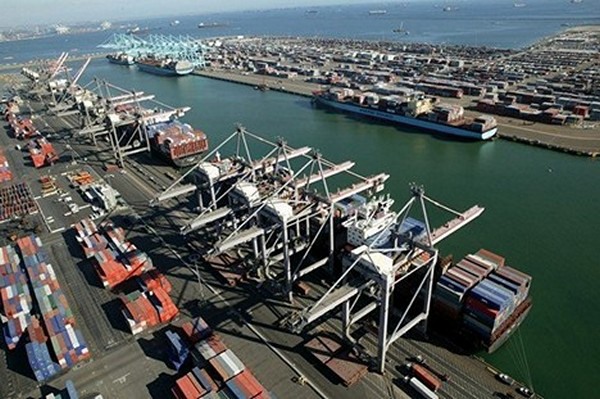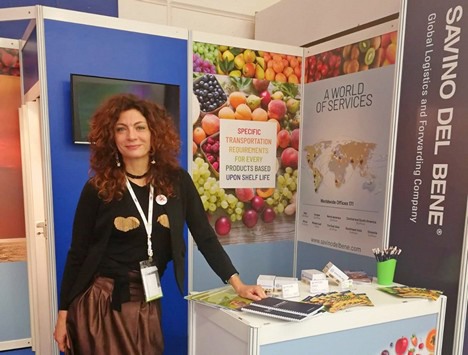FreshPlaza talked about the current situation in the international logistic sector with Linda Carobbi, Corporate Director Fresh Fruit and Vegetable Vertical Market at Savino Del Bene S.p.A., a global logistic and shipping company.
"We ended 2020 with a total of around 608,000 TEUs shipped all over the world by sea and 51 million kg by air. The overall turnover of the group substantially equaled that of 2019, i.e. over €1.6 billion despite the unique year. The Group opened 13 offices in North America, Europe, Far East, Oceania, North Africa and Middle East," reports Linda.
 Linda Carobbi
Linda Carobbi
FreshPlaza (FP): What is happening globally in the logistics sector?
Linda Carobbi (LC): The pandemic continues to affect international maritime logistics. This Chinese New Year's Eve could have a particular meaning when it comes to International Shipping, for both chilled and dry goods. Over the last three months of 2020, China has gone back to standard production levels and, with America and Europe continuing working from home, demand for so-called 'stay-at-home' products, which are mostly made in Asia, gradually increased. Carriers, however, have not returned to pre-Covid hold capacity levels.
FP: What is the balance between demand/supply?
LC: The huge hold demand for Transpacific trade (i.e. from the Far East to the US West Coast) continues to push carriers to prioritize placing empty containers in the Far East to benefit from the incredibly high market rates. This has led to a lack of empty containers in other parts of the world. To this, we must add the commercial tension of the past two years between China and the US, which increased flow imbalance: for every three complete containers that go from China to the US, only one goes back full. More or less the same goes for the flows between Asia and Europe.

FP: Are there other areas in difficulty?
LC: North America is also experiencing difficulties at the moment. The huge volumes arriving to American ports have had an impact also on the productivity and efficiency of the ports themselves. Various ports in North America started experiencing heavy congestion: Vancouver, Long Beach, New York, to name a few. The ports of Los Angeles/Long Beach registered a peak of 22.5% in September 2020 year-on-year. The congestion has considerable consequences:
- reduction and slowdown of productivity and ship unloading/loading operations;
- ships forced to remain anchored outside of the main ports of destination and transhipment waiting for an available slot or to slow down to reach the port only when a slot is available (for example, in mid-January 2021, there were 32 ships outside of the Los Angeles and Long Beach ports waiting for their turn);
- port terminals have difficulty making appointments for container collection and locating containers;
- slowdown of land transport operations of containers once they are unloaded.
This prevents carriers from maintaining a regular flow in the return of empty containers (once unloaded in their final destination), which of course causes an imbalance in their handling and availability. To put it simply: there is a lack of empty containers and ship space available for various trades worldwide as well as a tangible difficulty in maintaining regular ship schedules on a global level. Recently, some carriers have announced they are not taking new bookings for Canada and Mexico at existing rates, meaning "spot" rates must be requested for each booking. Other carriers are not accepting loads for Colombo in Sri Lanka or have no availability for 2-3 weeks.
FP: What about sea fright?
LC: They have increased all over the world: many observers predicted the situation would continue until the Chinese New Year's Eve. To make an example regarding dry-goods containers, it has not been so expensive to import from the Far East by sea to Italy in years - shipments from Shanghai to Genoa are recording increases exceeding 200% compared to one year ago. Northern Europe is not doing any better, as sea fright between Shanghai and Rotterdam skyrocketed by over 220%. Congestion Surcharges or Equipment Imbalance Surcharges amounting to hundreds of Euros are frequently applied overnight.

Recently, the CEO of a leading German shipping company explained that the lack of workers and interrupted operations in some ports contributed to this situation and added that, in the past, carriers always managed to react to these situations by adding tonnage so as to guarantee the weekly frequency of regular services. However, ships are now filled beyond their capacity and it is not possible to do more.
FP: What to expect in the medium period?
LC: In the best of hypotheses, analysts forecasted a re-balance of the current trend after the Chinese New Year's Eve. If carriers choose to not reposition empty containers in Asia quickly and will not start building new boxes, the current situation may continue well beyond February.
